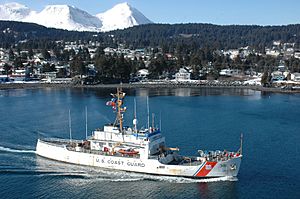USCGC Storis (WMEC-38) facts for kids

The USCGC Storis (WMEC-38), after decommissioning.
|
|
Quick facts for kids History |
|
|---|---|
| Name | USCGC Storis |
| Ordered | 26 January 1941 |
| Builder | Toledo Shipbuilding Company, Toledo, Ohio |
| Cost | $2,072,889 USD |
| Laid down | 14 July 1941 |
| Launched | 4 April 1942 |
| Commissioned | 30 September 1942 |
| Decommissioned | 12 February 2007 |
| Motto | ALASXAM ILAQAAN MAYAAQISNIIKACHXIIZAX (Great Hunter of Alaskan Waters) |
| Nickname(s) |
|
| Fate | Scrapped |
| General characteristics | |
| Displacement | 2,030 long tons (2,060 t) |
| Length | 230 ft (70 m) |
| Beam | 43 ft 2 in (13.16 m) |
| Draft | 15 ft (4.6 m) |
| Propulsion | Diesel-electric |
| Speed | 14 kn (26 km/h; 16 mph) |
| Range | 22,000 mi (35,000 km) |
| Complement | 12 officers; 72 enlisted (2006) |
| Sensors and processing systems |
SPS-64 I-band navigation search radar |
| Armament |
|
|
USCGC STORIS (cutter)
|
|
| NRHP reference No. | 12001110 |
| Added to NRHP | December 31, 2012 |
The USCGC Storis was a special ship that worked for the United States Coast Guard. It was a light icebreaker and a medium endurance cutter. The Storis served for over 64 years, making it the oldest ship in the Coast Guard fleet when it stopped working. Its nickname was "The Galloping Ghost of the Alaskan Coast."
Contents
Serving During World War II
The Storis was built in Toledo, Ohio, starting in 1941. It was launched in April 1942 and began its service in September 1942. The ship was first sent to the North Atlantic during World War II.
Patrolling Greenland's Waters
The Storis was part of the Greenland Patrol. Its main job was to patrol the east coast of Greenland. This was to stop German forces from setting up secret weather stations there. These stations could have helped German submarines and planes.
The ship's name, "Storis," comes from a Scandinavian word meaning "great ice." This was a good name for a ship working in icy waters.
A Difficult Convoy Mission
In June 1943, the Storis was escorting a group of ships called a convoy. They were traveling from Greenland to Newfoundland. Other Coast Guard ships were with them, including the Escanaba.
Suddenly, the Escanaba sank very quickly. No one heard an explosion. The Storis and another ship, the Raritan, searched for survivors. They only found two people alive from the Escanaba's crew of 103. This was a very sad and mysterious event during the war.
Life After World War II
After the war, the Storis moved to Juneau, Alaska in 1948. Here, it started a new important job called the Bering Sea Patrol.
Helping Remote Alaskan Villages
During the Bering Sea Patrol, the Storis brought important services to isolated villages in Alaska. This included medical, dental, and legal help. It was like a floating clinic and courthouse for people living far from cities.
The ship also helped set up LORAN radio-navigation stations in Alaska. These stations helped ships and planes find their way. The Storis also delivered supplies for the Distant Early Warning Line, which was a system of radar stations. It also mapped unknown waters in the Arctic.
Exploring the Arctic Ocean
In 1957, the Storis went on a special mission with two other Coast Guard cutters, the Bramble and the Spar. Their goal was to find a deep channel through the Arctic Ocean. They also collected information about the ocean's depth and features.
After this trip, the Storis moved its homeport to Kodiak, Alaska.
Changes and Upgrades
In 1972, the Storis got a big upgrade. It was changed from a light icebreaker to a medium endurance cutter. This meant its main jobs changed. It started focusing on enforcing laws and treaties related to fishing in the Bering Sea and Gulf of Alaska.
The ship had another major update in 1986. Its engine system was replaced. They also made the living areas bigger, adding new rooms for women crew members and a lounge for everyone.
Storis in Media
The Storis was involved in a famous rescue in March 1990. It helped the fishing vessel Alaskan Monarch near Saint Paul Island. Videos of this rescue are often shown on TV shows like Deadliest Catch. These videos highlight how dangerous it can be to work in the Bering Sea.
The Storis also appeared briefly in the 2006 movie The Guardian.
End of Service
The Storis officially stopped working for the Coast Guard on February 8, 2007. This ceremony took place in Kodiak, Alaska. After that, the ship sailed to California. It became part of the National Defense Reserve Fleet, also known as the "Mothball Fleet."
In 2012, the Storis was added to the National Register of Historic Places. This means it was recognized as an important historical item.
However, in 2013, the Storis was put up for sale. It was later towed to Mexico to be taken apart for scrap metal.
Awards and Honors
The Storis received many awards during its long service. These include:
- Coast Guard Presidential Unit Citation
- Secretary of Transportation Outstanding Unit Award
- Coast Guard Unit Commendation (8 awards)
- Coast Guard Meritorious Unit Commendation (7 awards)
- Coast Guard E Ribbon (11 awards)
- Coast Guard Bicentennial Unit Commendation
- American Campaign Medal
- European-African-Middle Eastern Campaign Medal with one battle star
- World War II Victory Medal
- National Defense Service Medal with three service stars
- Coast Guard Arctic Service Medal (8 awards)
- Global War on Terrorism Service Medal
- Humanitarian Service Medal
- Special Operations Service Ribbon

